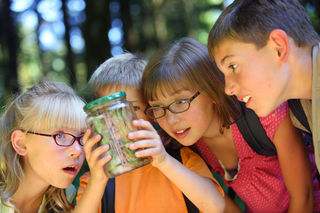This is a highly adaptable model for other mentoring or community organizations.
Cleverly organizers held the event at the University of Oklahoma's Health Science Center's Student Union so attendees were on a college campus. This also made having health science professors, students, and recruiters there along with many interactive STEAM activities.
Making and Firing Rockets
Kendall Brown, "Rocketeer"
Dee Liggons, Rocketeering Recruiter
The cost of making the rockets is minimum, and youths can be as creative as they wish. Young people really enjoyed this activity.
Air-Powered Spinning Machine from Boeing
Richard Laskey, a University of Oklahoma graduate and a Boeing employee, conducted the air-powered spinning machine station.
Circuit Boards - built from everyday things, e.g., the motor from an inexpensive electric toothbrush.
STEM Outreach Coordinator for Rose State College, Michael Garrison, who has an M.S. in aerospace administration and logistics, was so enthusiastic about this project. For some time, we observed him enthralling two young people, one of elementary age and one of middle school or high school age. When not representing Rose State, Garrison also has his own company, S.T.E.A.M. I AM to illustrate science, technology, engineering, and math for youths.
Catapults & Foil Boats Ferrying Gummy Bears - Girl Scouts of Western Oklahoma
Julien Warren and Sharice Robinson had pans of water, foil, and Gummy Bears to allow attendees to construct their own boats, load them with Gummy Bears, and see if the construction plan worked. In addition, they had wooden tongue depressors, plastic spoons, cupcake/candy papers, and rubber bands to build catapults to hurl marshmallows. Girl Scouts is "all over" STEM curriculum.


Worm Power
While observing this activity, an elementary-age girl kindly and eagerly offered me her tiny worm, which I took gleefully and handed back. The inquisitive young lady was fascinated and fascinating.
College of Dentistry
The large set of teeth was a kid magnet. These college "recruiters," really a professor and a student, had an interesting prop and dynamic personalities. Dr. Bernard Rhine, left, and Charles Mosley, a second-year dental student, make a significant impression on kids and us.
College of Allie Health
Allied Health encompasses all of the careers listed above.
Susan Tucker, assistant dean for Student Affairs, College of Allied Health, not only had a giant cereal box but also a leg with muscles, etc.
Brent Ross, outreach and recruitment coordinator for the College of Medicine-Admissions, also answered questions of attendees and discussed opportunities in medicine.
Heath Burge, the assistant dean for Student Affairs for the University of Health Sciences Center, on behalf of the College of Nursing made a special effort to be at the STEAM event.
Circuit Boards II

At this station, we asked the young student enjoying the activity to tell us about it, and he did. Bravo! Class Matters "provides science, technology, engineering and mathematics (STEM) exposure to socially and economically disadvantaged youth in Oklahoma City" since 2010. http://class-matters.org/
More OUHSC Options
Zelina Estrada, OUHSC Student Affairs/Campus and Community Life coordinator, discusses opportunities. Yes, she has a variety of props including the skeleton.
College of Pharmacy

OETA, Oklahoma Education Televisional Authority, has so many educational avenues for all ages. OEA can help lay the foundation early on and along a youth's growth. Representing OETA is Darrell Strong, program manager. Strong also has his own business as DJ ProSTAR.
Engineers
Enthralling youths with knowledge and charisma were Jasmine McCloud, a mechanical engineer (B.S.) and a biomedical engineer (M.S.), and Gerald Fleming, an electrical engineer in addition to mathematics and music technology specialties. Their company is Bandkhamp.

Organizer-in-Chief
The event's organizer-in-chief is Violet Ford, director of education and family development for the Urban League of Greater Oklahoma City. Having met Violet in 2012, we have watched her can-do spirit and creative vision steadily grow innovative education programming and community.
The Urban League of Greater Oklahoma City has really thrived in its programming with passionate, outgoing, genuine, and highly goal-focused leadership and staff. We salute them all. https://www.urbanleagueok.org/
Not pictured: Carrie McClain, Jabar Shumate, and D'Andre Fisher provided connections between Urban League and the health science center. Shumate is vice president of OU's University Community, McClain is associate director for the HSC, and Fisher is special assistant to Mr. Shumate, the vice president, and director of operations.
The Urban League of Greater Oklahoma City effectively executes Project Ready, the signature mentoring program of the National Urban League. http://www.iamempowered.com/programs/project-ready




































"Nature's Peace Will Flow Into You...While Cares Drop Off Like Autumn Leaves"
5 Ways Outdoor Learning Optimizes Children's Overall Well-Being
Outdoor Learning Improves Well-Being by Creating 5 Outcomes:
Conclusion: Access to Nature Improves Well-Being Throughout Your Lifespan